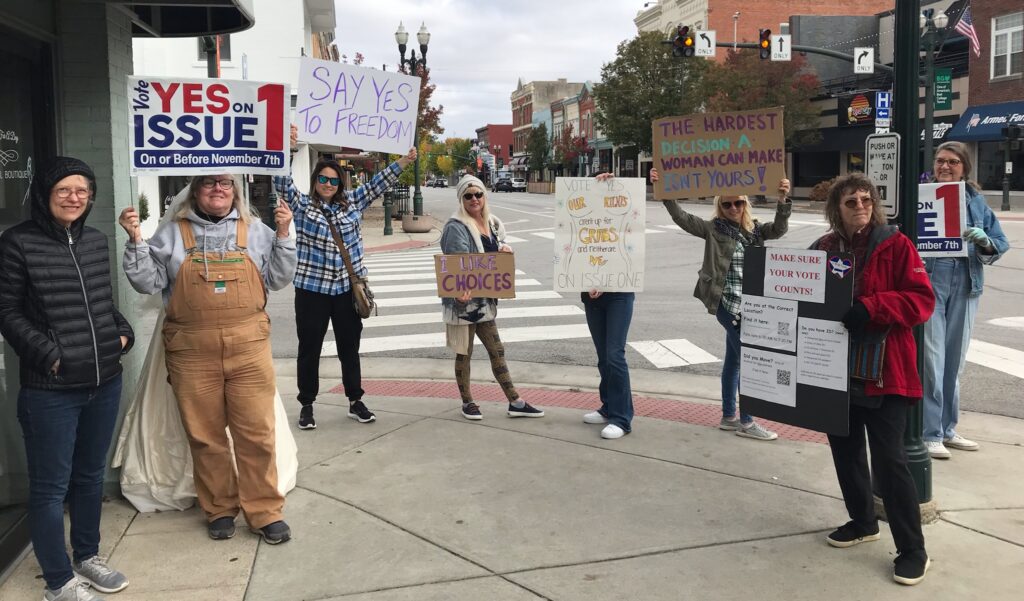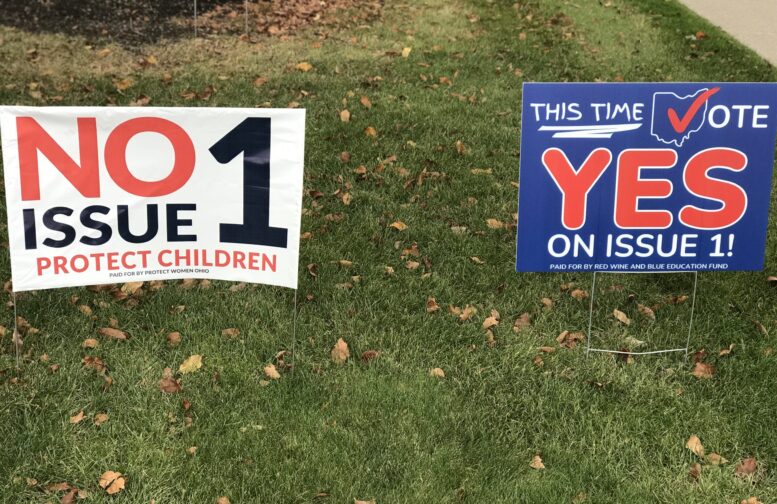By JAN LARSON McLAUGHLIN
BG Independent News
The nation is watching to see where Ohio voters will land next week on the issue of reproductive rights.
Closer to home, some Bowling Green residents are engrossed in the emotional battle – some fighting to regain those rights, while others are fighting to further restrict them.
State Issue 1, on the Nov. 7 ballot, is a constitutional amendment for reproductive rights. While the language of the amendment focuses primarily on abortion, if passed it would also cement into the state constitution the right to miscarriage care, fertility treatments, contraception, and the right to continue one’s own pregnancy.
Last weekend, a group of women stood at the four corners in downtown Bowling Green, trying to make voters aware of the reproductive rights that hang in the balance.
Holly Gray-Luring, mother of three, said she is voting for Issue 1 because she wants her children to have the same rights she had. When attending a party in college at age 19, Gray-Luring said she was raped by a man she didn’t know.
“I did not tell anyone – not even my mother,” she said.
Gray-Luring said she went to Planned Parenthood for an abortion. “There were people screaming that I was a murderer,” she said.
Now, as leader of the “Bowling Green Persists” organization, she occasionally encounters similar anger as she rallies for reproductive rights. “People yell at us to keep our legs closed,” Gray-Luring said.
Motivated by the overturning of Roe V. Wade, she continues to push for passage of State Issue 1.
“I want those medical options to be available for other women,” she said.
But others, like State Senator Theresa Gavarone, R-Bowling Green, believe Issue 1 would be harmful to women. Though she did not return a phone call to BG Independent News, Gavarone has repeatedly shared her opposition to the issue.
“Issue 1 would have disastrous effects on women and children in our state by allowing painful, late-term abortions to be written into our state constitution,” she reportedly said during a recent meeting of the anti-Issue 1 group, Protect Women Ohio, in Sandusky.
Not everyone sees it that way.

“The government has no place in a person’s decisions on contraceptives, fertility treatment, miscarriage care, continuing a pregnancy or abortion,” said Karen Woods, who rallied in downtown BG with a “Vote Yes” sign.
She was joined by Debbie Dalke, who had already cast her ballot on the issue.
“I voted for Issue 1 because I’m really terrified of what will happen if it fails,” Dalke said.
The amendment would allow for a legal choice on abortion, contraception, fertility treatment, miscarriage care and continuing a pregnancy. It would also prohibit the state from interfering or penalizing an individual’s voluntary exercise of this right or anyone or entity that helps in utilizing this right.
Passage of Issue 1 would enshrine those rights in the state constitution.
Failure of Issue 1 means an unknown – though likely far more restrictive – future for reproductive rights in Ohio.
Republican lawmakers in Ohio passed a six-week abortion ban in 2019, which had no rape or incest exceptions. This law was blocked by a federal judge a few months later.
When Roe fell in 2022, Ohio reinstated the six-week ban. Pro-abortion rights groups sued, and months later, a state judge indefinitely blocked the law from going into place.
Ohio’s six-week abortion ban remains in statute, even if a federal court has put it on hold. That law carries an exception for the life of the mother, but not for rape or incest. In practice, however, the policy makes it difficult to get an abortion, since medical providers are reportedly leaving the state due to restrictive and confusing abortion policies.
“Doctors have this dilemma,” Dalke said. “They want to care for their patients, but do not want to lose their license.”
Advocates for Issue 1 often point to the state’s policy that led to a 10-year-old rape victim having to be transported to Indiana for an abortion.
Dalke fears the implementation of the six-week ban – “at a time when women don’t even know they are pregnant.” If the ban becomes reality, “more women are going to die,” she predicted.
Scare tactics over ‘parental rights’
Many of the “No” signs dotting local lawns state that voting down the issue would protect parents’ rights.
But Woods pointed out that Issue 1 does not negate parental rights.
“It says nothing about parents’ rights,” she said. “It wouldn’t preempt any parental consent laws. It’s a non-issue to create confusion.”
The amendment also does not address gender changes.
“It’s a scare tactic,” Woods said. “There is nothing about kids being able to change their gender. It basically says women get to make decisions about reproductive issues.”
Gray-Luring stressed parents’ rights are not at risk in the amendment.
“It’s about the right to freedom and choice. It does not take away parental rights,” she said.
Dalke pointed out that even Ohio Attorney General David Yost acknowledged that the amendment would not deny parents’ rights. After a legal analysis of Issue 1 in October, Yost said “the amendment does not specifically address parental consent.”
Language in a constitutional amendment must be specific, and words that aren’t in the amendment should not be read as being implied. Current law requires minors to get parental consent, and this amendment would not change that.
That statement from Yost, however, has not quieted the misleading and inaccurate information being put out against Issue 1.
In a TV ad made for Issue 1 opposition group Protect Women Ohio, Gov. Mike DeWine and First Lady Fran DeWine speak against the measure. Fran DeWine is shown in the ad saying Issue 1 “would deny parents the right to be involved when their daughter is making the most important decision of her life.”
Ballot language questioned
Proponents of Issue 1 say many voters are already confused about the repeat of an “Issue 1” on the ballot in August and in November. They are two separate issues, and many who voted in August against Issue 1, which would have made it more difficult to pass a reproductive rights amendment, are likely to support Issue 1 in November.
But when going door-to-door with informational material, Gray-Luring said she has encountered many voters who believe they already voted on this Issue 1, or believe they need to vote “no” again.
Dalke has also come across voters unaware of this Issue 1. “They say, ‘didn’t we already settle this?’”
Then there’s the ballot language, which is different from the actual amendment language.
Backers of Issue 1 wanted the state to use the actual amendment itself — which was the language on the petitions signed by more than 700,000 Ohioans. But Republicans who control the ballot board chose to go with wording written by Secretary of State Frank LaRose’s office.
Gavarone did not want the amendment language to be used on the ballot, calling it vague.
“No one should be fooled by the clever language of this amendment. It’s designed to be broad, so broad that should it pass, it is unequivocally true that access to late-term abortions will be written into Ohio’s constitution. This amendment is a bridge too far,” Gavarone said.
Actually, the amendment allows the state to ban abortions after viability, or around 23 weeks, when the fetus can survive outside the uterus – unless the pregnant woman’s doctor finds the procedure “is necessary to protect the pregnant patient’s life or health.”
That language, however, does not appear on the ballot. A summary from LaRose’s office instead says that the amendment “would allow an unborn child to be aborted at any state of pregnancy, regardless of viability.”
That falsehood has gotten traction, bolstered by messages like an ad aired during an Ohio State football game featuring Donald Trump warning if Issue 1 passes, “in the ninth month, you can take the baby and rip the baby out of the womb of the mother.”

